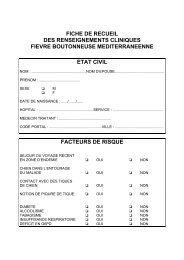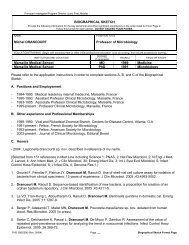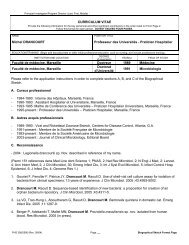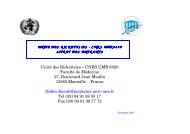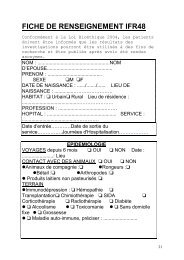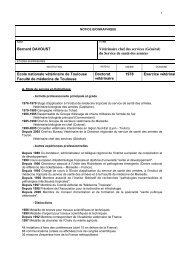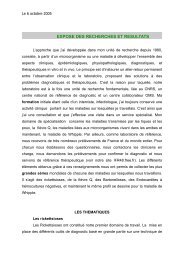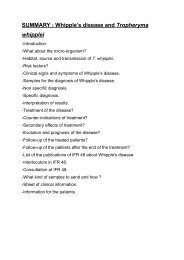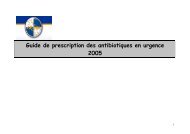Bartonella quintana
Bartonella quintana
Bartonella quintana
- No tags were found...
You also want an ePaper? Increase the reach of your titles
YUMPU automatically turns print PDFs into web optimized ePapers that Google loves.
cultures of skin biopsies, cardiac valves, or direct evidence ofthe presence of the bacterium by immunohistochemistryusing a specific monoclonal antibody, performed onhistological samples or in blood smears (detection in redblood cells). Genome amplification by PCR is also possible.The specific diagnosis also relies on indirect diagnosis(serology, western blot and cross adsorption).9. SerologyThe sensibility of serology varies regarding the technic used.The positive predictive value is about 65%. The cutoffvalue of antibody titers varies regarding the technique used.Serology is particularly usefull during B. <strong>quintana</strong> bacteremiaand during <strong>Bartonella</strong> sp. endocarditis. We consider, in ourlaboratory, an IgG titer of more than 1:100 significant duringbacteremia, and an IgG titer of more than 1:800 highlycorrelated with the presence of an endocarditis. Duringendocarditis, patients exhibit antibodies against all <strong>Bartonella</strong>species, while patients with chronic bacteremia withoutendocarditis only develop antibodies against B. <strong>quintana</strong>.Serological diagnosis however has its own limits. Antibodytiters vary regarding antigen preparation technique. Bacterialantigens prepared grown onto eukaryote cell cultures yieldhigher antibody titers than those grown in axenic media.Another point is that some patients infected by <strong>Bartonella</strong> sp.do not demonstrate detectable specific antibodies. This is thecase for immunocompromised patients, which is a limit forthe diagnosis of bacillary angiomatosis. Serological tests alsolack specificity. Cross reactions between the different speciesof <strong>Bartonella</strong> have been demonstrated, as between<strong>Bartonella</strong> sp. and Chlamydia and Coxiella burnetii.Picture 7 Positive indirect immunofluorescence for B.henselae in a patient with cat scratch disease.




